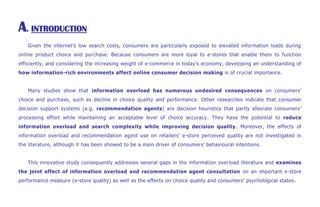
ACR Conference 2009, Pittsburgh
- 1. A. INTRODUCTION Given the internet’s low search costs, consumers are particularly exposed to elevated information loads during online product choice and purchase. Because consumers are more loyal to e-stores that enable them to function efficiently, and considering the increasing weight of e-commerce in today’s economy, developing an understanding of how information-rich environments affect online consumer decision making is of crucial importance. Many studies show that information overload has numerous undesired consequences on consumers’ choice and purchase, such as decline in choice quality and performance. Other researches indicate that consumer decision support systems (e.g. recommendation agents) are decision heuristics that partly alleviate consumers ’ processing effort while maintaining an acceptable level of choice accuracy . They have the potential to reduce information overload and search complexity while improving decision quality . Moreover, the effects of information overload and recommendation agent use on retailers’ e-store perceived quality are not investigated in the literature, although it has been showed to be a main driver of consumers’ behavioural intentions. This innovative study consequently addresses several gaps in the information overload literature and examines the joint effect of information overload and recommendation agent consultation on an important e-store performance measure (e-store quality) as well as the effects on choice quality and consumers’ psychological states .
- 2. B. CONCEPTUAL FRAMEWORK AND THEORICAL BACKGROUND INFORMATION BITS INFORMATION OVERLOAD Alternatives / Attributes / Info Structure Perceptions NEED FOR COGNITION E-STORE EVALUATION RECOMMANDATION AGENT Site quality dimensions Consultation and Outcome CHOICE CONFIDENCE / CHOICE QUALITY DIFFICULTY Distance btw utility fct of Consumers’ optimal and actual choice psychological states
- 3. C. METHOD 1 – Pretest (1) To execute manipulation checks, (2) to ensure relevance of product category, and (3) to determine most important product attributes to be included in main experi ment Method: o 6 versions of the questionnaire (only 1 on 3 section differed throughout every version number) o 77 participants from a snowball sample Results: o Manipulation checks successful (number of alternatives; attributes levels; info structure) o Product category is relevant: high levels of experience and familiarity observed within participant base o 35 out of the 45 considered product attributes included in main experiment based on attributes weights 2 – Laboratory experiment Method: o 466 participants o Complete website created for a fictitious retailer o Task consists in choosing one laptop with the option to consult a recommendation agent prior to final choice o Recommendation was based on each participant’s utility function and represented optimal choice o Retailer’s and laptop manufacturers’ names were not disclosed to prevent bias o Presentation order of laptops was randomized for each participant to avoid presentation bias
- 4. C. METHOD (CONTINUED) Variable manipulations: o Manipulation levels were adapted from literature to ensure appropriate information load increments o Participant randomly assigned to 1 of 18 experimental conditions (3 X 3 X 2) 6, 18 or 30 alternatives in product choice set 15, 25 or 35 attributes per alternative in product choice set Disproportional (more diagnostic info) or proportional (less diagnostic info) distribution of attribute levels across alternatives Measures: o Measurement of participants’ utility functions (based on personal attributes evaluation) and some of the dependant variables occurred prior to task execution o Scales were adapted/translated from existing reliable and valid scales o Dependant variables: perceived information overload (2 items) choice confidence (3 items) choice difficulty (1 items) choice quality (distance between utility functions of optimal and actual choice ) need for cognition (18 items) site information quality (3 items) site interactivity (4 items) o Control variables: consumer product experience (3 items) product category involvement (4 items) sex, age, education, income
- 5. Effect of Recommendation Consultation Supported relation D. RESULTS on Site Interactivity is not significant. All other relations are supported. Not supported relation INFORMATION BITS INFORMATION OVERLOAD Alternatives / Attributes / Info Structure Perceptions NEED FOR COGNITION E-STORE EVALUATION RECOMMENDATION AGENT Site quality dimensions Consultation and Outcome CHOICE CONFIDENCE / CHOICE QUALITY DIFFICULTY Distance btw utility fct of Consumers’ optimal and actual choice psychological states
- 6. E. CONCLUSION This research has several novel findings and implications on research and practice . It contributes to the information overload literature by integrating the traditional and structural met hods of product information measurement and by investigating the relationship between information bits and overload perceptions. Results show that consumers evolving online in an information-rich environment tend to employ information- processing heuristics in response to information overload, with strong positive impact s on choice quality. Indeed, this study is one of the first to establish a link between shopping strategy (use or non -use of a recommendation agent) and performance (choice objective quality and e-store quality). It is also one of the first studies to link a shopping outcome (final product chosen) to the e -store’s perceived quality (i.e., site interactivity). Integrating a recommendation agent that considers consumers’ preferences and person alizes product choice accordingly appears to be beneficial for both consumers (by improving choice quality and confidence) and retailers (by enhancing the e-store quality and helping consumers make a choice of higher quality) .
